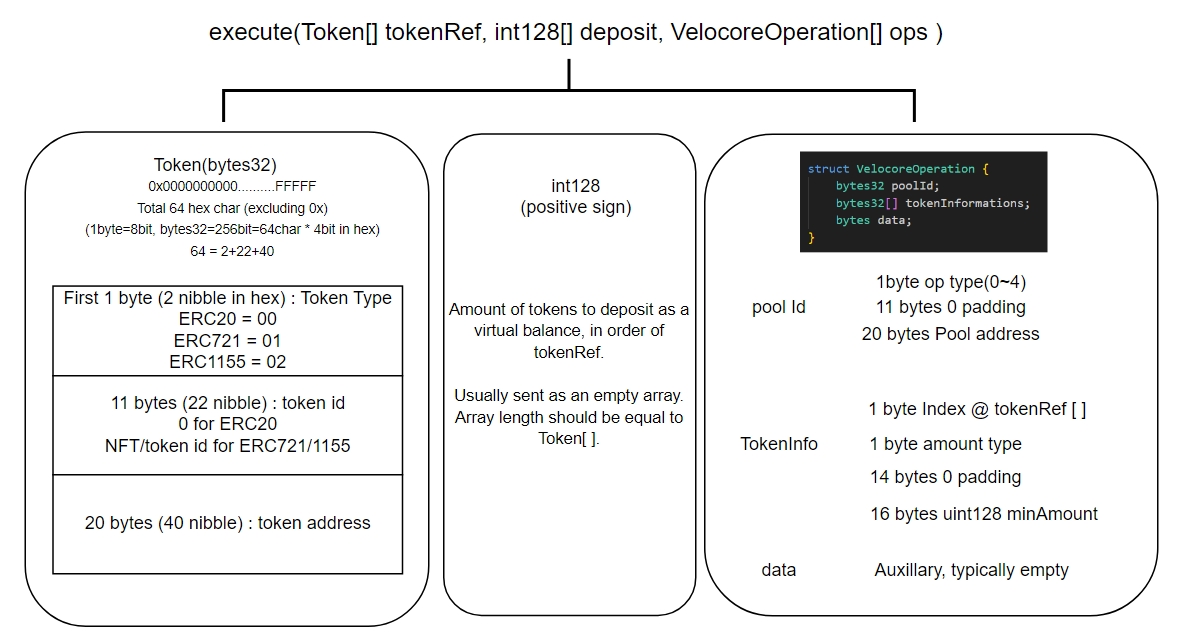Execute() for Chaining & Complex Operations
Execute(), one function to do all the SWAP/LPing/Vote/Stake/bribe/etc.
All actions in Blade are done through the Vault contract. You don't have to go to each address of Router, Factory, Gauge, etc. and interact with them separately; all you need is the Vault contract address to do everything.

Vault.execute() is the main function for transactions. This function receives Operation from the user, executes them in sequence while tracking the user's virtual balance, and finally carries out token transfers.
Tokens are transferred only after all operations are executed, and the virtual balance can even go negative, which indicates an impending payment by the user.
1. tokenRef
tokenRef is an array of Token(type bytes32) (less than 256 elements), listing all tokens involved in transactions. For instance, [USDC, ETH, VC].
It supports not only ERC20 but also ERC721, ERC1155, and native tokens. Tokens are represented as a wrapped bytes32 (Token), specifically:
1 byte of token type
0x00: ERC200x01: erc7210x02: erc1155
11 bytes of token id:
always 0 for ERC20
NFT id or Token id for ERC721 and erc1155
token ids greater than 2^88 - 1 is unsupported
20 bytes of token address
native token is represented as 0xeeeee...eeeee.
2. deposit
deposit is an array of positive int128 matching the length of tokenRef. Vault withdraws specified amounts from the user before transactions and credits these to the virtual balances. It's useful for selling tax-on-transfer tokens. Usually, this is an array of zeroes.
3. Operation
Operation is an abstraction of the swap process. Users sendOperations to the Vault to perform swaps. Each operation includes operation type (e.g., swap, stake, vote), the pool to interact with, and details like Token, desired amount, and nature of the amount.
An example of a transaction that pays USDC to buy ETH is conceptualized as:
We use a compressed encoding to optimize calldata usage.
poolId: A bytes32 combination of1 byte of operation type:
0x00: swap
0x01: stake
0x02: convert
0x03: vote
0x04: userBalance operations
(11 bytes of unused bytes)
20 bytes of
Pooladdress
tokenInformation: A bytes32 combination of:1 byte (uint8) of the index of the
TokenintokenRef1 byte of
amountType0x00: exactly
0x01: at most
0x02: equal to the virtual balance
14 bytes of unused bytes
16 bytes of
int128, thedesiredAmountthe transaction will fail, regardless of the
amountType, if the pool returns less than this.
data: Auxiliary data, typically empty bytes.
tokenInformation must contain for all tokens involved, including VC emitted during (un)staking and veVC deposited/withdrawn during voting.
Pool implementations define specific requirements for operationType, tokenInformation, and data. The Vault only ensures the result is less than desiredAmount. Each Operation can be viewed as a desired token balance change vector, with auxiliary data.
Beware of malicious pools that might confiscate deposited tokens. Users shouldn't use Pool addresses blindly.
Operation Type Differences
Swap applies to any token exchanges not involving VC emission or voting. It includes swap, veVC conversion, and LP deposit/withdrawal.
ISwaprefers to pools supporting this opertaionFor CPMM(Volatile pools) and Wombat pools, LP deposit/withdrawal can be performed by 'buying/selling' LP tokens from/to underlying tokens.
This is an important concept. Adding/removing liquidity is not a separate function, it's the act of swapping tokens for LP tokens!
VC and veVC are ISwap; VC can be 'bought' with old VC; and veVC can be bought with old veNFTs or new VC. ( This was only used in zkSync in the past, migrating from v1 to v2, and is now obsolete )
the plan is to make veVC act as the liquidity pool for veVC; this is not implemented yet.
Stake diverges from swap as the Vault calculates and emits VC before operation. It is used for interacting with gauges.
IGaugerefers to pools supporting this opertaionCPMM is both
ISwapandIGauge.Wombat pools have multiple gauges; one for each lp token.
Harvesting can usually be performed by specifying [VC, at most, 0], without any lp tokens.
Convert involves actual token transfer, different from swap. The Vault transfers desiredAmount to the pool before calling the pool, and the pool sends the output to the vault.
IConverterrefers to pools supporting this opertaion.Vault only monitors specified tokens balance changes; any unspecified tokens received will be lost.
This is useful for converting tokens to/from wrapped tokens (e.g. WETH) for flash loans.
Vote is significantly different from swap. This operation requires the pool to be IGauge, and tokenInformation must include veVC and any bribe tokens user wants to receive. Like stake, it sends VC emission and calculates and sends any bribes attached to the gauge. To (un)vote, users must specify the desiredAmount of the veVC. Any bribes not included in tokenInformation will be credited to userBalance instead.
Harvesting can usually be performed by specifying [veVC, exactly, 0], along with bribe tokens.
userBalance:
userbalance is the user's token-specific balance held in the vault, unused, and available for withdrawal at any time, stored in userbalance[useraddress][Token]. pro traders can save gas by preloading their tokens into userBalance to avoid having to perform a token transfer every time they trade.
Pool in this operation can be any address, allowing depositing any tokens to any address. Withdrawal is only possible from your userBalance.
Vault.query()
To determine the expected amounts received from transactions, use Vault.query(). The function parameters are the same as before, with the addition of user, which specifies the transaction maker. The function returns an array of int128 representing the final transactional changes in token balances.
Helper Code
Last updated